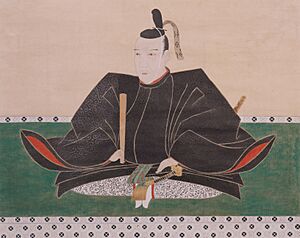Kikkawa Hiroie facts for kids
Quick facts for kids
Kikkawa Hiroie
|
|
|---|---|
| 吉川 広家 | |
 |
|
| Lord of Iwakuni | |
| In office 1601–1615 |
|
| Succeeded by | Kikkawa Hiromasa |
| Head of Kikkawa clan | |
| In office 1587–1614 |
|
| Preceded by | Kikkawa Motoharu |
| Succeeded by | Kikkawa Hiromasa |
| Personal details | |
| Born |
Tsunenobu (経信)
December 7, 1561 |
| Died | October 22, 1626 (aged 64) |
| Nationality | Japanese |
| Children | Kikkawa Hiromasa |
| Parent |
|
| Military service | |
| Allegiance | |
| Unit | |
| Commands | Iwakuni Domain |
| Battles/wars | Siege of Kōzuki Castle (1578) Korean Campaign (1592-1598) Battle of Sekigahara (1600) |
Kikkawa Hiroie (吉川 広家) (born December 7, 1561 – died October 22, 1626) was an important Japanese daimyō. A daimyō was a powerful feudal lord in old Japan. He lived during the Azuchi–Momoyama period and the start of the Edo period. These were times when Japan was ruled by powerful warrior families. Hiroie's father was Kikkawa Motoharu. His mother was a daughter of Kumagai Nobunao.
Contents
Early Life and Rise to Power
Kikkawa Hiroie was first named Tsunenobu. He began his life as a warrior in 1578. His first battle was against Amago Katsuhisa, fighting alongside his father.
In 1583, he was sent to Toyotomi Hideyoshi. Hideyoshi was the most powerful ruler in Japan at that time. Hiroie went as a hostage, which was a way to show loyalty between powerful families.
Becoming a Clan Leader
Between 1586 and 1587, both his father and older brother, Kikkawa Motonaga, passed away. This meant Hiroie became the new head of the Kikkawa clan. Around this time, he changed his name to Hiroie.
Unlike his father and brother, who were famous for their bravery in battle, Hiroie preferred smart plans and talking things out. He used strategy and diplomacy to win. Hideyoshi greatly respected Hiroie for keeping the Mōri clan strong. This happened after the death of another important leader, Kobayakawa Takakage.
Fighting in Korea
Hiroie also took part in the Seven-Year Korean War. He is especially known for defeating a much larger Chinese army. This happened at the siege of Ulsan castle.
The Battle of Sekigahara
In the year 1600, a huge battle took place called the Battle of Sekigahara. Hiroie believed that the side led by Tokugawa Ieyasu would win. However, his own clan, the Mōri clan, was on the other side. The Mōri clan leader, Mōri Terumoto, supported the forces loyal to the Toyotomi family.
Hiroie's Secret Plan
To protect his clan, Hiroie made a secret deal with the Tokugawa side. He promised that the Mōri clan would stay neutral during the battle. In return, the Tokugawa side promised not to take away the Mōri clan's lands. He made this deal through a man named Kuroda Nagamasa.
Mōri Terumoto was the official leader of the Western Army. But he stayed in Osaka Castle. The Mōri army on the battlefield was led by Mōri Hidemoto, with Hiroie leading the front lines.
Actions During the Battle
On the day of the battle, September 15, the Mōri army was positioned to attack the Tokugawa forces. When Hidemoto ordered an attack, Hiroie refused. He used his troops to block the paths, stopping the Mōri army from joining the fight.
Because of Hiroie's actions, most of the Mōri army did not fight in the battle. Tokugawa Ieyasu won the battle.
Aftermath of the Battle
After the victory, documents were found that seemed to show Mōri Terumoto was more involved with the Western Army than Hiroie had said. Ieyasu felt the secret deal was broken. At first, Ieyasu wanted to take all of the Mōri clan's lands. He offered Hiroie two provinces as a reward.
This offer surprised Hiroie. His goal was to save the Mōri clan, not to gain land for himself. Eventually, Ieyasu changed his mind. He reduced the Mōri clan's lands to just two provinces. This was on the condition that Mōri Terumoto would retire. Hiroie managed to save the Mōri clan's status as daimyō. However, they lost more than three-quarters of their land.
Clan Reaction and Legacy
Hiroie had made the secret deal without his clan's knowledge. Because of this, he faced strong criticism from his own family. Many thought he was a traitor. They felt his actions during the battle led to their clan's huge loss of land. Hidemoto, in particular, became a strong rival to Hiroie within the Mōri clan.
After the battle, Terumoto gave Hiroie a part of his smaller domain. People sometimes mistakenly think Hiroie was the first ruler of the Iwakuni han (a local domain). However, Hiroie and his family were not made daimyō in their own right until much later. They remained important officials of the Mōri clan.
Later Life and Death
In 1614, Hiroie stepped down as clan leader. His eldest son, Kikkawa Hiromasa, took his place.
Hiroie passed away in 1626, twelve years after he gave up his leadership role. He worked hard for the success of his domain. He is remembered for creating a set of 188 laws for his people, known as the Kikkawa-shi hatto.
| Preceded by none |
Daimyō of Iwakuni 1601–1615 |
Succeeded by Kikkawa Hiromasa |
| Preceded by Kikkawa Motonaga |
Kikkawa family head 1587–1614 |
Succeeded by Kikkawa Hiromasa |

